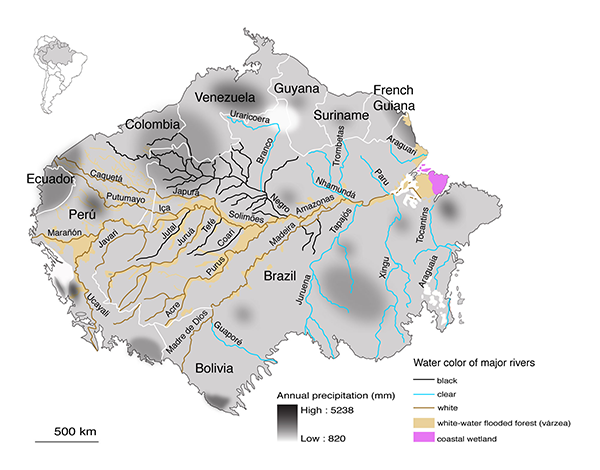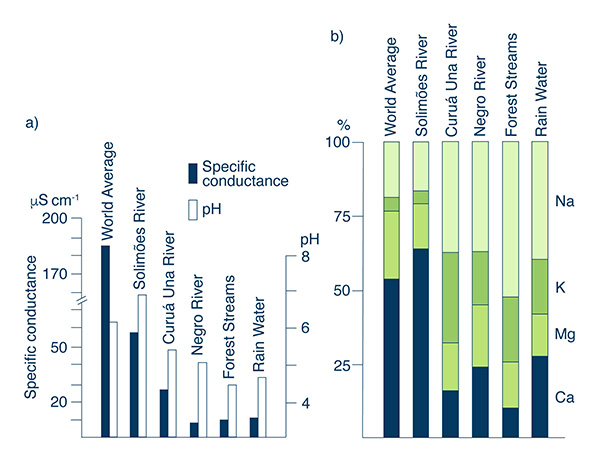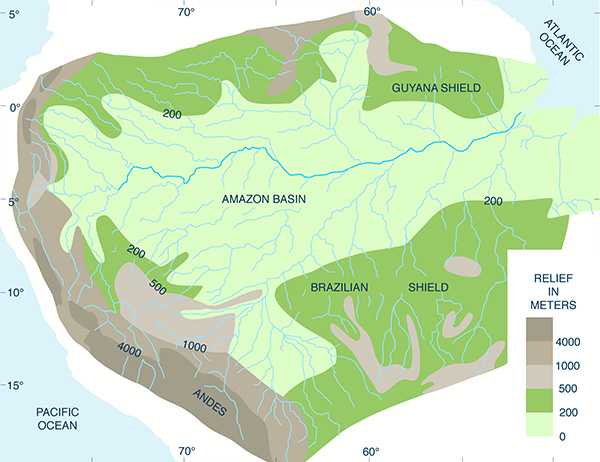1. CLASSES OF AMAZONIAN RIVERS
The Amazon basin is the largest in the world, encompassing
approximately
The waters of Amazon rivers feature different colors, which
are readily discernible.
Native pre-Columbian inhabitants classified the rivers attending to the color
of their waters. They knew that the color of the water indicated differences
in its quality, fish resources, soil fertility, and the presence/absence of
mosquitos. Subsequently, scientists used river color
to classify Amazon rivers into four types: (1) Clear river (Rio Claro), (2) Black
river (Rio Negro or Rio Preto),
The first attempt to develop a scientific classification of Amazonian
rivers was performed
in the 1950s by Harald Sioli (Junk, 2001). He used the
color of the waters, as well as various physical and chemical characteristics,
to explain the limnological properties of major Amazonian rivers. Sioli related
these characteristics to the geological and geomorphological properties
of the contributing drainage basins (Fig. 1) (Junk et al., 2011).
Fig. 1 Spatial
distribution of major Amazon basin
blackwater, clearwater,
Sioli established three types of water color in major Amazonian rivers: (1) clear,
Fig. 2 Clearwater, whitewater and blackwater river colors.
The color of a river's water is the result of physical and chemical
transformations that take place during surface and subsurface runoff.
In the Amazon basin, whitewater draining from the Andes Mountains
(for example, the Solimões river in Brazil, referred to as the
Amazon river in Peru) has a relatively high concentration
of nutrient-rich sediments; thus, its light-brown color. On the other hand,
blackwater, originating in
the central-northern rainforest
Fig. 3 Selected physico-chemical properties of Amazonian rivers:
(a) specific conductance (at 20 °C) and pH;
2. THE SOLIMÕES RIVER: WHITEWATER
Most western Amazonian rivers are classified as whitewater (Fig. 1).
The white waters are generally muddy, containing large quantities
of sediment, often with a brownish tint.
The headwaters of whitewater rivers lie toward the west,
in the Andes Mountains of Ecuador, Peru, and Bolivia and
carry large amounts of nutrient-rich sediments,
giving the water its characteristic light-brown color.
In addition, at the prevailing (high) temperatures, the mainly
alkaline earth metals and carbonates determine the muddy
coloration of whitewaters, with a relatively high value of electrical
conductivity. In the upland basins, this value is approximately
100 μS cm-1, decreasing to
40 μS cm-1 in the lowland basins. Moreover, the pH of
whitewaters is close to neutral (Furch and Junk, 1997).
These rivers deposit their nutrient-rich sediment in extensive
floodplain areas, referred to as várzeas in the Portuguese language. Therefore,
the várzeas are very fertile and covered by highly productive
terrestrial and aquatic herbaceous communities, which reach beyond
the várzea forests.
Sediments carried by whitewater rivers consist of large
amounts of fine-grained material.
In mountainous environments, physical weathering is more likely
to predominate
over chemical weathering.
3. THE NEGRO RIVER: BLACKWATER
The blackwater rivers, among them, the Negro, Jutaí, Tefé and Coari rivers,
feature much darker color tones.
This is due to the soil chemistry and to the local geology, geomorphology, and hydrology.
Blackwaters are poor in nutrients and the surrounding soil is predominantly sandy,
containing large amounts of organic matter, such as humic and fulvic acids, which lend the water
its characteristic black color.
Although the water surface appears dark in color, collecting the river water
in a transparent bottle will reveal a color tint varying from red to dark brown.
The red waters
found in the Negro river at São Gabriel da Cachoeira, in the central-northern Amazon, fall
into the black water category because they are acidic waters containing
a high quantity of humic acids,
which give it a reddish-brown color (Gibbs, 1967).
Most headwaters in the northwestern Negro tributaries have transparent waters with up to 3 m Secchi depth,
featuring low amounts of suspended matter. They drain the waters originating in the
Precambrian Shield of Guyana, characterized
by large areas of white sands (podzols). This is the case of the Branco river, a tributary of the Negro
river, which has a high load of suspended matter and the appearance of a whitewater river. However, the
chemical characteristics of these rivers indicate that they generally have a low nutritional status and
a closer relationship with clearwater rivers. They become blackish in color and very acidic after
flowing through areas covered by dense rainforest (Junk et al., 2011).
The German naturalist Alexander von Humboldt referred to these forests as Hylean
in the early 19th century.
Blackwater rivers feature pH values in the range 4-5 and low electrical conductivity,
below
The floodplains of blackwater rivers, locally referred to as igapós,
feature generally low fertility,
Terrestrial and aquatic herbaceous plants are scarce and many typical whitewater species are absent due to either
low fertility, low pH, or both. Sandy beaches suffer severe drought stress due to their low water
retention capacity. Downstream of the Negro River, near the confluence with
whitewaters and a greater availability of nutrient-rich sediments,
there is a larger number of plants
Fig. 4 Meeting of the waters of the Negro river (blackwater, right) and Solimões river (whitewater, left).
4. THE TAPAJÓS AND XINGU RIVERS: CLEARWATER
The larger Amazonian rivers featuring clearwaters are the Trombetas,
Tapajós and Xingu rivers.
Clearwater rivers usually have tones varying from greenish to transparent.
They originate in the Amazonian cratons, i.e.,
very old rock formations dating from the Archean period (Pre-Cambrian);
therefore, they have very small amounts of sediment (Junk et al., 2011).
Cratons exist in two regions of the Amazon basin: (1) toward the north, as the Guiana (Guayana) shield, and (2) towards the
center-south, as
the Brazilian shield (Fig. 5). These rock formations underlie a characteristically
flat relief, with very little surface erosion and low quantities of organic matter;
consequently, the waters are clearer (Gibbs, 1967).
Fig. 5 Generalized map showing the relief of the Amazon Basin (Silva et al., 2013). Large clearwater rivers have an electrical conductivity ranging from 10 to 50 μS cm-1, which may decrease to 5 μS cm-1 for lower-order streams. The pH is acidic, ranging from 5 to 7, while the transparency of its greenish waters is over 100 cm and may exceed 350 cm. The floodplains of clearwater rivers, also referred to as igapós, are generally of intermediate fertility (Junk et al., 2011). They are covered by a slow-growing floodplain forest, where litter production is approximately 30% lower than in other forested areas. The growth rate of trees in the igapós are up to two-thirds lower than those found in the várzeas (Furch and Junk, 1997). Clearwater rivers receive their water mostly from rainfall, with little or no sediment production in the contributing uplands. Their wetlands are generally poor in nutrients; however, their nutritional status may vary due to differences in soil quality in the neighboring cerrados, the tropical savannas of central Brazil. Submerged macrophytes may occur in areas featuring deep light penetration and little water level fluctuation. Thus, the diversity of aquatic macrophytes is greater in clearwater rivers than in comparable whitewater or blackwater rivers (Rios-Villamizar et al., 2014).
5. THE FACES OF THE RIVERS
The Amazon basin as a whole features three major landscapes: (1)
the Andes Mountains, toward the west; (2) the crystalline
shields (cratons) of Guyana, toward the north, and Brazil, toward the southeast;
and (3) the sedimentary plains in the central portion, the domain
of the Hylean forest. The geological characteristics of the lands where these landscapes are located
determine the chemical composition of the waters of the various rivers.
Not only are the chemical characteristics quite distinct, but there is also a visual
difference. This fact led Sioli to classify the rivers
into: (a) clearwater, (b) whitewater, and (c) blackwater (Table 1) (Silva et al., 2013).
Sioli's
classification has been supported by botanists and limnologists, who found corresponding differences in the occurrence
of tree species, aquatic macrophytes and aquatic biota, such as snails, bivalves, and other species
The combination of various dissolved solids and chemical characteristics, such as the amount and relationship between alkali and alkaline earth metals, and major anions (bicarbonates and chlorides), electrical conductivity, pH, total nitrogen, water color, turbidity and transparency, enable the identification of three classical types of river water: (1) white, (2) black, and (3) clear, In addition, there are other mixed waterbodies of intermediate color. As the order of a river increases, the complexity tends to be hidden, because the river flow provides the integration of all waters, thereby mixing waters of different qualities. The distribution of alkali metals, alkaline earth metals, and of major anions is particularly useful for distinguishing between whitewater, blackwater and clearwater rivers. Greater variability is shown by bodies of water that do not fit into the three classical categories. Therefore, many streams and rivers may actually be considered of "mixed waters," resulting from the influence of lower-order tributaries with different physicochemical characteristics (Gibbs, 1967).
REFERENCES
Furch, K. and W. J. Junk. 1997. Physicochemical conditions in the floodplains, Chapter 4 in W. J. Junk, ed.,
The Central Amazon Floodplain. Ecological Studies, 126, 69-108, Springer-Verlag, Berlin.
Junk, W. J. 2001. Appraisal of the scientific work of Harald Sioli. Amazoniana, 16(3), 285-297.
Junk, W. J., M. T. F. Piedade, J. Schongart, M. Cohn-Haft, J. M. Adeney, and F. Wittmann. 2011.
Gibbs, R. J. 1967. The geochemistry of the Amazon river system. Part I: The factors that control the salinity and the composition and concentration of the
suspended solids. Geological Society of America Bulletin, 78, 1203-1232.
Ponce, V. M. 1992. Letters to South American Explorer, 31, May 1992.
Ríos-Villamizar, E. A., M. T. F. Piedade, J. G. Da Costa, J. M. Adeney, and W. J. Junk.
2014. Chemistry of different Amazonian water types for river classification: A preliminary review. Water and Society II, 178, 17-28.
Silva, M. S. R., S. A. F. Miranda, R. N. Domingos, S. L. R. Silva, and G. P. Santana. 2013.
Classification of Amazonian rivers: A strategy for the preservation of these resources. Holos Environment, 13(2), 163-174.
| ||||||||||||||||||||||||||||||||||||||||||||||||||||||||||||





